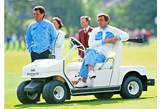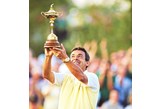Tony Jacklin: The man who saved the Ryder Cup
Published:
Without Tony Jacklin’s vision and drive, the Ryder Cup might still be a meaningless mismatch. Here he explains how he saved the day…
Once upon a time, not all that long ago, the Ryder Cup was dying a slow, painful death. Since its inaugural matches in 1927, the Americans had won 16 of the 19 events, often without breaking sweat. The addition of Irish players in 1973 did little to turn the tide.
Having witnessed the 12.5-7.5 humiliation in 1977, The Observer’s Peter Dobereiner wrote: “In America, the Ryder Cup now rates somewhere between Tennessee Frog Jumping and the Alabama Melon-Pip Spitting Championship”.
Great Britain & Ireland then became Europe but the USA won again in 1979. And again in 1981 at Walton Heath – this time by a record 18.5-9.5 margin. “We went into it with the idea that it was a foregone conclusion,” admitted Tom Watson. “That’s not to be big-headed. It was just a matter of fact.” But things were about to change.
Tony Jacklin played in seven Ryder Cups and suffered with the difference in professionalism between the teams. In 1975, the soles of his cheap, plastic shoes fell off on the putting green as he took on Raymond Floyd. “We were two-down before we had hit a shot, just on the basis of how we were made to feel,” he despaired.
By 1983, Jacklin had had a bellyful of the event, but when the PGA approached him to captain the side six months later at Palm Beach Gardens, he sensed an opportunity.
“I knew if I was to accept the job, I wanted to do it on my own terms,” he recalled. What followed changed the Ryder Cup forever, as Jacklin himself now explains…

What made you think you could turn Europe’s Ryder Cup fortunes around?
I had played in seven Ryder Cups and I just thought our approach was totally wrong. When Tom Weiskopf got picked for the American team in 1977 but decided not to play because it was no longer any kind of contest, the writing was on the wall. It was clear that we needed a radically different approach if we were to win.
How did you come to be appointed captain?
When I was approached, I’d grown disillusioned by the way they treated people. Seve was not in the team at the time (he missed 1981 after an argument over appearance money) and I just didn’t know what Europe was trying to do. The US thought all they had to do was keep turning up to win, which wasn’t far from the truth. So I was finished with the whole thing. When I was approached, I was angry enough to not care and I didn’t answer the call immediately. I gave it some thought and said I wanted free reign to put it right.

What did you want to change?
Just being on even terms with how the Americans approached it. For example, something so simple as having a team room where we could gather. We had never had that prior to 1983, we just huddled in the corner of locker rooms. There was nowhere to create the team spirit required. We were down before we even hit a ball because of our self-esteem. We were literally flying on the back of the bus while the Americans were flying Concorde, we had plastic shoes and they had the best. So I asked for all of those things and they kept saying yes. So, in the end, I said yes too.
How did the players react to the changes?
You could see how they responded by the fact we came so close to winning in 1983 on US soil (a 14.5 – 13.5 defeat). Having had two matches in ’79 and ’81 that had made no difference whatsoever, we were now close and it was clear what I instigated had worked. We used ’83 as a stepping stone to winning for the first time in 28 years.

One of the changes you made in 1983 was to bring Seve back into the team…
I had to get Seve back in the team to get the thing working. Seve was as angry as I was, if not more so, and yet he was prepared to come back in. They had never sat down and they didn’t know how to accommodate him in the team. He was Tiger Woods before Tiger Woods ever came along. He was a guy who was very hurt by what had happened to him. His pride was hurt and he was a proud person, but once I got him talked round he gave Europe 500 percent. Getting Seve was one part of the big picture.
Once the pieces were in place, we felt like a team and our self-belief grew.
What made you ask for the extra wild card?
Because the top 10 qualified and No.9 could qualify without winning. You could get in by just playing a lot. I didn’t want that. I wanted winners on my team and matchplayers as well. You could qualify by strokeplay but matchplay is completely different and many great matchplayers are not necessarily great strokeplayers. So, I just wanted the ability to pick an extra player.

In ’89 your big names lost in the singles and yet you still tied (14-14). How important are the lesser names in Ryder Cups?
Seve, Faldo and Woosie all lost. It was the supposed ‘lesser men’, Ronan Rafferty and Christy O’Connor Jnr, who stood up. If team unity is good, these guys are going to come through. We were all equal in that team room, there were no egos. Eamonn Darcy holed the putt that meant we couldn’t lose in 1987.
You wouldn’t have thought that would happen, but it does happen in the Ryder Cup. They are all obviously good players – you don’t get on a Ryder Cup team if you’re not a good player – but the team aspect is absolutely key to it. It elevates some and makes everyone feel equal.
How do you find and establish a successful Ryder Cup pairing?
You get a feel for it. Seve was very difficult to partner initially as his own team-mates were in awe of him. Jose Rivero was one. I put Paul Way with Seve in ’83. Paul was only 20, but he was cocky and wasn’t fazed by playing with Seve. He probably thought he was going to be as good as Seve, so he had that arrogance of youth. It was one of my best moves. I’d heard Seve wasn’t happy with the pairing, so I asked him what was wrong. He said, “This boy, I tell him, no, no, no, no, don’t use this club, use that club, I feel like his father.” I said, “Seve, you are his father in here,” and pointed to my head. “You are playing with him to guide him, is that a problem?” The penny dropped, his back straightened, and he said, “For me, that is not a problem”.
Langer you could put with anybody. He wasn’t overly friendly; he was just Bernhard and he would do his thing and come through for you. Faldo and Woosnam worked wonderfully at Muirfield Village, but that partnership wore out after that one event. People move on, but you can tell watching them and watching their body language whether they are doing it for themselves or for the other person.
I was in the middle of it all and watching everybody’s eyeballs and the body language, so it became obvious to me. I was living it.

How did you decide the order of the singles?
In 1983, I just turned the list upside down. Historically, the strong players went to the end and when we opened the envelope and Jack saw I’d put my best players at the top he literally said, “You can’t do that”. But there is no point in having your strength at the end if you’ve lost by then.
That was the problem in 1999 – we had a four-shot lead and we should have powered it out, but we lost the impetus.
Did you ever ask the players for any input?
No, I think Davis Love was asking his guys who they wanted to play with. How would they know? You are the captain and if you start showing things to the floor you are going to get a really muddy picture. That was the way I did it.
I ran a few things by Seve from time to time, but in the end he said, “Tony, don’t ask me, you are a great captain, you do it”.
What was your management style with the players?
I made it my business to have a one-to-one relationship with everybody. Faldo in 1985 was going through a divorce and I didn’t think he was firing. One morning I said he didn’t look like he was playing his best, so asked if he wanted another go or if I should put Ken Brown in. I said as a captain, I want your honest opinion on this. He said put Ken in.
It was about managing characters, managing egos, and making sure nothing falls through the cracks, but being human about it.
READ NEXT:
– Who will play together for Team Europe?
– Meet Europe’s secret weapon
– Do Ryder Cup players get paid?
About the Author

Rob McGarr – Contributing Editor
Rob McGarr is a freelance contributor at Today’s Golfer.
He has been a writer and editor for over 15 years, covering all manner of subjects, including golf (obviously).
You can follow him on YouTube where – depending on what day of the week it is – he’ll either be trying his best to get his handicap down to scratch or shoving his clubs in a cupboard, never to be seen again.
He’s also on Twitter and Instagram, which is pretty ironic considering he generally loathes social media.
Rob is a member at Royal North Devon, where he plays off a four-handicap.
Rob uses a Callaway GBB Epic Sub Zero driver, Ping G 3-wood, Callaway X Forged UT 18 2-iron, Ping i25 irons, Cleveland RTX-3 wedges, TaylorMade Spider X Hydro Blast putter and the Bridgestone Tour B XS golf ball.
You can get in touch with Rob here.
-
 Tony Jacklin played a key role in making the Ryder Cup a competitive contest after years of American domination
Tony Jacklin played a key role in making the Ryder Cup a competitive contest after years of American domination
-
 Tony Jacklin captained Europe to victory at the 1985 Ryder Cup
Tony Jacklin captained Europe to victory at the 1985 Ryder Cup
-
 Tony Jacklin and Jack Nicklaus didn't always see eye-to-eye as Ryder Cup captains
Tony Jacklin and Jack Nicklaus didn't always see eye-to-eye as Ryder Cup captains
-
 A Ryder Cup captain needs eyes everywhere, as Tony Jacklin discovered
A Ryder Cup captain needs eyes everywhere, as Tony Jacklin discovered
-
 Tony Jacklin had reached a point of hating the Ryder Cup, so he knew he had to do something to change it
Tony Jacklin had reached a point of hating the Ryder Cup, so he knew he had to do something to change it
-
 Tony Jacklin made it his mission to get Seve Ballesteros back on the Ryder Cup team
Tony Jacklin made it his mission to get Seve Ballesteros back on the Ryder Cup team
